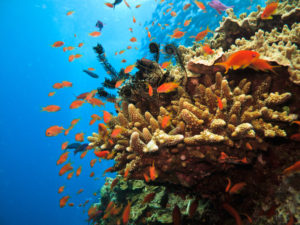
Coral reefs are home to a vast diversity of marine life. Like rainforests, they act as “lungs” for the planet, providing 70% of our oxygen. They’re dying out, so we need to act. But what can we do to restore coral reefs?
[Coral reefs] are the rainforests of the ocean. They exist on vast scales: half a trillion corals line the Pacific from Indonesia to French Polynesia, roughly the same as the number of trees that fill the Amazon. They are equally important havens of biodiversity. Rainforests cover 18% of the land’s surface and offer a home to more than half its vertebrate species. Reefs occupy 0.1% of the oceans and host a quarter of marine species.—”Those in peril in the sea,” The Economist, 2 June 2022
Coral reefs also protect coastal lands from flooding and erosion. That is, they serve as natural breakwaters, mitigating the action of ocean waves.
Normally, coral and algae have a symbiotic relationship. The algae shelters in the coral and provides food for it. Rising temperatures cause the algae to produce toxins instead of oxygen. The coral rejects them, causing bleaching. Without the food the algae provides, the coral dies.
Corals, which are sessile animals related to sea anemones, host within their tissues algae that provide them with both food and their tourist-attracting colours. But as temperatures rise, the photosynthetic mechanisms of these algae go haywire. Instead of molecular oxygen, the normal waste product of photosynthesis, they start generating highly reactive and therefore toxic oxygen-rich compounds, such as peroxides. If they do this to excess, their hosts expel them, bleaching the coral concerned white.—”Corals are threatened by global warming,” The Economist, 2 June 2022
How can we restore coral reefs?
In previous blogs we’ve discussed green energy, net zero concrete, green stormwater infrastructure, and green construction practices. But even if the world acts swiftly to limit water pollution and greenhouse gases, climate change is already in progress. If we want to mitigate the effects, we need direct measures to protect vulnerable ecosystems.
Some corals are naturally heat resistant. Scientists are considering ways to identify them and relocate them to supplement more vulnerable varieties. Cross breeding of these corals with others could result in better heat resistance. While less likely to meet with widespread acceptance, genetic engineering corals for heat resistance is also a possibility. Overall, assisting evolution can cause concern, but may be necessary to restore coral reefs before it’s too late.
It’s not just coral
Other components of the coral ecosystem also need attention. Heat-resistant varieties of algae may fare better than the native ones. And scientists are also studying the microorganisms that live on coral reefs to see whether they might enhance heat resistance. Some corals are more heat resistant than their close relatives, suggesting that other factors besides genetics are also at work.
Microbiomes—the collectives of bacteria, fungi and viruses that cohabit with most animals, especially in their guts—are now taken seriously as physiological influencers. The human microbiome has been connected…to conditions ranging from obesity to Alzheimer’s disease, and gut microbes are essential to the digestive processes of animals as diverse as cattle and termites. There is no reason for corals to be exempt from their influence.—”Corals are threatened by global warming,” The Economist, 2 June 2022
Experiments have shown that injecting microbes from heat-resistant corals into less resistant ones improved their heat resistance considerably. This approach shows much more flexibility than breeding corals for heat resistance. And it would take far less time to produce results.
During the years 2015-2018, Australia’s Great Barrier Reef lost more than 30% of its coral to bleaching. However, because of its size, the Great Barrier Reef may not be the best place to experiment. After all, it’s as large as Italy. But trials with smaller reefs could point the way to practical ways to restore coral reefs.
